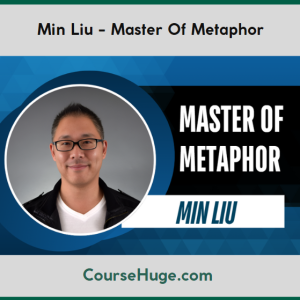Min Liu – Verbal Domination: The Weapons Of Verbal Combat
$199.00 Original price was: $199.00.$21.00Current price is: $21.00.
Min Liu The Weapons Of Verbal Combat Course [Instant Download]

1️⃣. What is The Weapons Of Verbal Combat?
Min Liu’s The Weapons Of Verbal Combat is a communication skills course that teaches you how to win verbal confrontations in real-life situations.
The course delivers 21+ proven verbal techniques to handle challenging conversations in business, social settings, and relationships.
Drawing from his experience as a corporate lawyer, Min shows you how to stay calm during verbal attacks and respond effectively, ensuring people never underestimate you again.
📚 PROOF OF COURSE


2️⃣. What you’ll learn in The Weapons Of Verbal Combat:
The Weapons Of Verbal Combat equips you with essential verbal skills for any confrontational situation. Here’s what you’ll learn:
- Frame control techniques to take charge of conversations
- Psychological warfare strategies to counter manipulation
- Weakness identification methods to target verbal opponents
- Non-verbal communication skills that strengthen your message
- Composure exercises to stay calm under pressure
- 21+ devastating verbal techniques you can use right away
This training helps professionals and individuals improve their verbal self-defense. You’ll master verbal combat skills not taught in regular education.
3️⃣. The Weapons Of Verbal Combat Course Curriculum:
✅ Section 1: Foundations of Verbal Domination
This section establishes the core concepts and theoretical framework necessary for understanding verbal domination. It introduces the fundamental principles that govern effective communication control and sets the stage for the more specific techniques covered later.
Module 1.1: Introduction to Verbal Domination
The module presents the concept of verbal domination and its applications in various contexts. It explores how mastering these techniques can transform communication dynamics and provide strategic advantages in conversations.
- Introduction To Verbal Domination (HTML)
- Introduction To Verbal Domination (MP3)
Module 1.2: Framework Development
This module outlines the structural approach to verbal domination, establishing the foundation upon which all techniques are built. It provides a comprehensive overview of how different elements work together.
- The Framework For Verbal Domination (HTML)
- The Framework For Verbal Domination (MP3)
✅ Section 2: Core Ingredients of Verbal Domination
This section breaks down the essential components that comprise effective verbal domination. Each ingredient represents a distinct skill area that contributes to conversational control and influence.
Module 2.1: Frame Control
The module focuses on establishing and maintaining conversational frames. It examines how frame control serves as the primary mechanism for directing interactions and shaping perception.
- Ingredient #1 Frame Control (HTML)
Module 2.2: Rules of Engagement
This module covers how to establish the parameters of conversation to your advantage. It explores timing elements and setting conditions that favor your position.
- Ingredient #2 Rules of Engagement (HTML)
- More On Playing With The Time Element (PDF)
- Ingredient #2 Rules of Engagement (MP3)
Module 2.3: Optimal Targeting
The module teaches strategic selection of conversational targets to maximize effectiveness. It demonstrates how proper targeting enhances persuasive impact.
- Ingredient #3 Optimal Targeting (HTML)
- Ingredient #3 Optimal Targeting (MP3)
Module 2.4: Indirectness
This module explores subtle communication approaches that avoid triggering defensive responses. It reveals how indirect methods often prove more effective than direct confrontation.
- Ingredient #4 Indirectness (HTML)
- Ingredient #4 Indirectness (MP3)
Module 2.5: Psychological Warfare
The module examines psychological principles that influence perception and decision-making. It applies cognitive and emotional insights to communication strategy.
- Ingredient #5 Psychological Warfare (HTML)
- Ingredient #5 Psychological Warfare (MP3)
Module 2.6: Specific Techniques Overview
This module introduces the concept of tactical verbal techniques and their application. It provides the transition to the more specific methods covered in the next section.
- Ingredient #6 Specific Techniques (HTML)
- Ingredient #6 Specific Techniques (MP3)
✅ Section 3: Advanced Verbal Techniques
This section presents twenty-one specific verbal techniques that can be tactically deployed in various situations. Each technique represents a distinct tool for conversational control and influence.
Module 3.1: Techniques 1-7
This module covers the first set of verbal techniques, focusing on redirection and reframing conversational elements.
- Technique #1 The Fake Out (HTML)
- Technique #2 Clubs, Teams, and Groups (HTML)
- Technique #3 The Made Up Backstory (HTML)
- Technique #4 Translation (HTML)
- Technique #5 Future Projection (HTML)
- Technique #6 Says Someone (HTML)
- Technique #7 Negation (HTML)
Module 3.2: Techniques 8-14
This module explores techniques centered on interpretation control and narrative manipulation.
- Technique #8 Redirection (HTML)
- Technique #9 Deliberate Misinterpretation (HTML)
- Technique #10 Devalidation (HTML)
- Technique #11 Unflattering Comparisons (HTML)
- Technique #12 Selective Misinterpretation (HTML)
- Technique #13 Absurdify The Subject (HTML)
- Absurdity (From The Hank Moody Guide To Wit) (PDF)
- Technique #14 The Snarky Call Out (HTML)
Module 3.3: Techniques 15-21
This module covers advanced techniques involving emotional manipulation and structural communication strategies.
- Technique #15 Tactical Tripwires (HTML)
- Technique #16 Playing With Emotions (HTML)
- Technique #17 Parallelism (HTML)
- Technique #18 Framing Metaphors (HTML)
- Technique #19 The Indirect Threat (HTML)
- Technique #20 Irony (HTML)
- Technique #21 Same Content, Different Form (HTML)
✅ Section 4: Advanced Frame Control
This section provides an in-depth exploration of frame control as the foundational element of verbal domination. It examines different types of frames and how they interact in conversations.
Module 4.1: Frame Control Fundamentals
This module delves deeper into the concept of frames and their critical importance in verbal interactions.
- Introduction To Frame Control (HTML)
- Introduction To Frame Control (MP3)
Module 4.2: Understanding Opponent Frames
The module focuses on recognizing and analyzing the frames used by conversational opponents.
- Your Opponent’s Frame (HTML)
- Opponent’s Frame (MP3)
- List of Potential Opponent Frames (PDF)
Module 4.3: Establishing Your Frame
This module teaches techniques for creating and maintaining strong personal frames in conversations.
- Your Frame (HTML)
- Your Frame (MP3)
Module 4.4: Context Management
The module examines how situational elements influence frame dynamics and can be leveraged strategically.
- Situational Frames (HTML)
- Situational Frames (MP3)
✅ Section 5: Strategic Applications
This section focuses on applying verbal domination principles in challenging situations. It provides strategies for turning disadvantages into advantages.
Module 5.1: Analytical Approaches
This module teaches systematic methods for breaking down and countering opposing arguments.
- Deconstructing Your Opponent’s Argument (HTML)
- Deconstructing Your Opponent’s Argument (MP3)
Module 5.2: Disadvantage Management
The module reveals techniques for maintaining conversational control despite unfavorable positions or facts.
- Turning Shit Into Gold How To Deal With Bad Facts and Weak Positions (HTML)
- Turning Shit Into Gold How To Deal With Bad Facts and Weak Positions (MP3)
✅ Section 6: Integration and Practice
This section helps students synthesize and apply all previously covered techniques through practical exercises and examples.
Module 6.1: Comprehensive Integration
This module demonstrates how different elements of verbal domination work together in real-world scenarios.
- Putting It All Together (HTML)
- Putting It All Together (MP3)
Module 6.2: Practical Application
The module provides structured exercises to reinforce learning and develop practical skills.
- Exercises Reinforcing What You Just Learned (HTML)
- Exercises – Reinforcing What You Just Learned (MP3)
- Sample Answers To Exercises (HTML)
- Sample Answers To Exercises (MP3)
Module 6.3: Continuing Development
This module offers guidance for ongoing skill development beyond the course.
- Keeping In Touch (HTML)
- Keeping In Touch (MP3)
4️⃣. Who is Min Liu?
Min Liu is a corporate lawyer and founder of The Art of Verbal War, teaching communication, persuasion, and influence. Based in San Francisco, he developed his verbal combat skills through legal practice and real-life experience.
Min learned these skills the hard way during his legal career and created a system to help others master verbal techniques not taught in schools.
He has written several books including “People Games,” “The High Value Man,” and “Verbal Self Defense 101,” all focused on communication and personal development.
Min’s teachings help professionals in law, business, and leadership. Attorneys, authors, and professionals praise his methods for their real-world effectiveness.
5️⃣. Who should take Min Liu Course?
The Weapons Of Verbal Combat is designed for individuals who want to excel in verbal confrontations and communication. This course is perfect for:
- Business professionals who need to handle difficult conversations and workplace conflicts effectively.
- Legal practitioners seeking verbal tactics beyond what’s taught in law school.
- Leaders and managers who must maintain authority when challenged verbally.
- Individuals struggling with confrontation who want to defend against verbal attacks confidently.
- Anyone seeking better communication in high-pressure situations.
If you’ve ever felt outmatched in a verbal exchange or wished for better responses in tough conversations, this course gives you practical tools to gain the upper hand.
6️⃣. Frequently Asked Questions:
Q1: How can I win a verbal confrontation?
Q2: What are the key skills for verbal communication mastery?
Q3: How do I stay calm during a heated argument?
Q4: How can I handle aggressive or manipulative speakers?
Q5: What are common verbal attack strategies, and how do I counter them?
Be the first to review “Min Liu – Verbal Domination: The Weapons Of Verbal Combat” Cancel reply
Related products
Communication Skills
Communication Skills
Morty Lefkoe – ReCreate Your Life – Natural Confidence Course + Money Course Bonus
Communication Skills
Communication Skills
Personal Development
Communication Skills
Communication Skills
Benny Lewis – Fluent in 3 Months Premium Package (12+ Languages)
Personal Development












Reviews
There are no reviews yet.